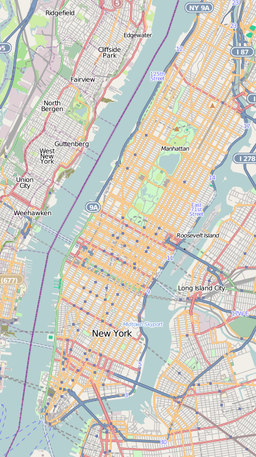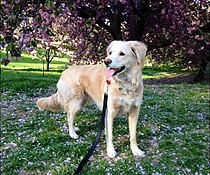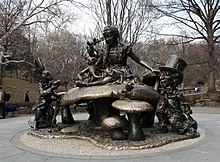
Central Park is an urban park between the Upper West Side and Upper East Side neighborhoods of Manhattan in New York City that was the first landscaped park in the United States. It is the sixth-largest park in the city, containing 843 acres (341 ha), and the most visited urban park in the United States, with an estimated 42 million visitors annually as of 2016.

Paul Howard Manship was an American sculptor. He consistently created mythological pieces in a classical style, and was a major force in the Art Deco movement. He is well known for his large public commissions, including the iconic Prometheus in Rockefeller Center and the Celestial Sphere Woodrow Wilson Memorial in Geneva, Switzerland. He is also credited for designing the modern rendition of New York City's official seal.

An exedra is a semicircular architectural recess or platform, sometimes crowned by a semi-dome, and either set into a building's façade or free-standing. The original Greek sense was applied to a room that opened onto a stoa, ringed with curved high-backed stone benches, a suitable place for conversation. An exedra may also be expressed by a curved break in a colonnade, perhaps with a semicircular seat.

Richard Morris Hunt was an American architect of the nineteenth century and an eminent figure in the history of architecture of the United States. He helped shape New York City with his designs for the 1902 entrance façade and Great Hall of the Metropolitan Museum of Art's Fifth Avenue building, the pedestal of the Statue of Liberty, and many Fifth Avenue mansions since destroyed.
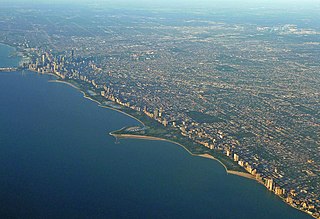
Lincoln Park is a 1,208-acre (489-hectare) park along Lake Michigan on the North Side of Chicago, Illinois. Named after US President Abraham Lincoln, it is the city's largest public park and stretches for seven miles (11 km) from Grand Avenue, on the south, to near Ardmore Avenue on the north, just north of the DuSable Lake Shore Drive terminus at Hollywood Avenue. Two museums and a zoo are located in the oldest part of the park between North Avenue and Diversey Parkway in the eponymous neighborhood. Further to the north, the park is characterized by parkland, beaches, recreational areas, nature reserves, and harbors. To the south, there is a more narrow strip of beaches east of Lake Shore Drive, almost to downtown. With 20 million visitors per year, Lincoln Park is the second-most-visited city park in the United States, behind Manhattan's Central Park.
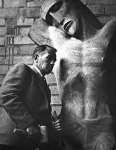
Albert Stewart was an American sculptor.

The Como Park Zoo and Marjorie McNeely Conservatory are located in Como Park at 1225 Estabrook Drive, Saint Paul, Minnesota. The park, zoo and conservatory are owned by the City of Saint Paul and are a division of Saint Paul Parks and Recreation. Its attractions include the zoo, the conservatory, an amusement park, a carousel, Lake Como, a golf course, a pool and more. The park receives more than 1.9 million visitors annually. Como Park is a free park and while no admission fee is charged for the zoo or conservatory, voluntary donations of $4 per adult and $2 child are suggested.

John Quincy Adams Ward was an American sculptor, whose most familiar work is his larger than life-size standing statue of George Washington on the steps of Federal Hall National Memorial in New York City.

George T. Delacorte Jr. was an American magazine publisher, born in New York City.

New York City's 843-acre (3.41 km2) Central Park is the home of many works of public art in various media, such as bronze, stone, and tile. Many are sculptures in the form of busts, statues, equestrian statues, and panels carved or cast in low relief. Others are two-dimensional bronze or tile plaques. Some artworks do double-duty as fountains, or as part of fountains; some serve as memorials dedicated to a cause, to notable individuals, and in one case, to a notable animal. Most were donated by individuals or civic organizations; only a few were funded by the city.

Assiniboine Park is a park in Winnipeg, Manitoba, Canada, located along the Assiniboine River.

The New England Society in the City of New York (NES) is one of several lineage organizations in the United States and one of the oldest charitable societies in the country. It was founded in 1805 to promote “friendship, charity and mutual assistance” among and on behalf of New Englanders living in New York.

The Conservatory Garden is a formal garden near the northeastern corner of Central Park in Upper Manhattan, New York City. Comprising 6 acres (24,000 m2), it is the only formal garden in Central Park. Conservatory Garden takes its name from a conservatory that stood on the site from 1898 to 1935. It is located just west of Fifth Avenue, opposite 104th to 106th Streets.

The Ramble and Lake are two geographic features of Central Park in Manhattan, New York City. Part of Frederick Law Olmsted and Calvert Vaux's 1857 Greensward Plan for Central Park, the features are located on the west side of the park between the 66th and 79th Street transverses.

Harlem Meer is a man-made lake at the northeast corner of New York City's Central Park. It lies west of Fifth Avenue, south of 110th Street, and north of the Conservatory Garden, near the Harlem and East Harlem neighborhoods of Manhattan. The lake, as originally constructed, was 12.634 acres (51,130 m2), but after the completion in 1966 of the Lasker skating rink and swimming pool, it was reduced to approximately 11 acres (45,000 m2) in area and approximately 0.75 miles (1.21 km) in circumference.

Waldo Hutchins was a New York attorney, businessman and politician. He served in the New York State Assembly and as a Member of Congress for three terms from 1879 to 1885.

Cedar Hill is an east-facing slope in Central Park, Manhattan, New York City. The hill is home to many red cedars that form a line of clumps on its crest. Low outcroppings of rock in the mowed turf were grooved and scarred by the last glacial period.

The Pond and Hallett Nature Sanctuary are two connected features at the southeastern corner of Central Park in Manhattan, New York City. It is located near Grand Army Plaza, across Central Park South from the Plaza Hotel, and slightly west of Fifth Avenue. The Pond is one of seven bodies of water in Central Park.

Eric Gugler was an American Neoclassical architect, interior designer, sculptor and muralist. He was selected by President Franklin D. Roosevelt to design the Oval Office.
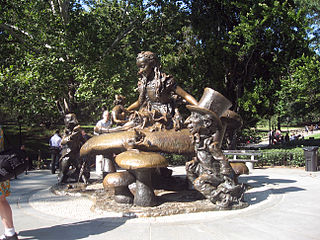
The Alice in Wonderland sculpture is located at Central Park in Manhattan, New York City, U.S. It is approximately at 74th Street, on the north side of Conservatory Water. The bronze statue stands eleven feet high and portrays Alice surrounded by the Mad Hatter, White Rabbit, Cheshire Cat and other characters from the book enjoying a tea party.

